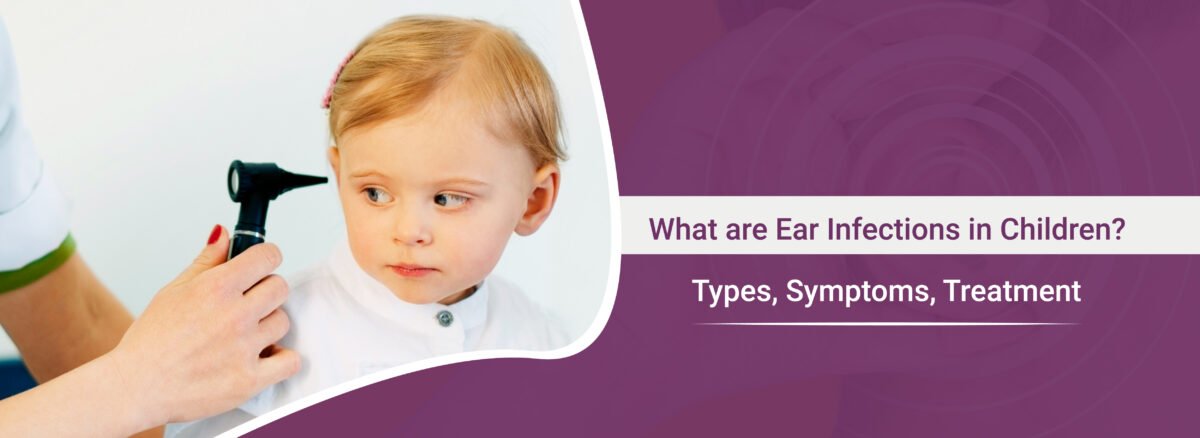Ear infections can be a common concern for parents of young children. These infections can cause discomfort and distress, but understanding the basics can help parents navigate through them more easily. In this article, we’ll explore what ear infections in children are, why they happen, their signs, and how to take care of your little one when they occur.
What Are Ear Infections in Children?
Ear infections, technically known as otitis media, are infections that affect the middle ear. The middle ear is the space behind the eardrum. When germs like bacteria or viruses get into this area, they can lead to infection and discomfort.
Types of Ear Infections
There are two main types of ear infections in children:
- Acute Otitis Media (AOM): This is the more common type. It often comes on suddenly and can cause symptoms like ear pain, fever, and fussiness.
- Otitis Media with Effusion (OME): This type involves fluid buildup in the middle ear without signs of an acute infection. It can happen after an AOM episode or by itself.
Why Do Kids Get Ear Infections?
Several factors can increase the likelihood of ear infections in children:
- Eustachian Tube Differences: Kids have shorter and more horizontal Eustachian tubes, which are small tubes that connect the middle ear to the back of the throat. These differences can make it easier for germs to travel from the throat to the middle ear.
- Colds and Infections: Common colds and other respiratory infections can lead to ear infections. They can cause congestion and swelling in the Eustachian tubes.
- Smoke Exposure: Being around tobacco smoke, whether during pregnancy or afterward, raises the risk of ear infections.
- Bottle Feeding Position: Feeding babies while they lie down can sometimes allow milk to flow backward into the Eustachian tubes, increasing the risk of infection.
Symptoms of Ear Infections
Ear infections can cause various symptoms in children, including:
- Ear pain or pulling at the ears.
- Fussiness or irritability, especially during feedings or bedtime.
- Difficulty sleeping.
- Fever.
- Fluid draining from the ear.
- Trouble hearing or responding to sounds.
It’s important to note that not all children will display the same symptoms, and some may not show any signs at all. If you suspect your child has an ear infection, it’s a good idea to consult a healthcare provider for a proper diagnosis.
How Are Ear Infections Treated?
Treatment for ear infections can vary depending on the child’s age and the severity of the infection. Here are some common approaches:
- Observation: In some cases, doctors may choose to monitor the infection without immediately prescribing antibiotics. This is often done for mild infections or when it’s uncertain if an infection is bacterial or viral.
- Antibiotics: When a bacterial infection is confirmed, antibiotics may be prescribed. It’s crucial to follow the full course of antibiotics even if the child starts feeling better.
- Pain Relief: Over-the-counter pain relievers like acetaminophen or ibuprofen can help ease ear pain and reduce fever. Be sure to follow the dosing instructions and consult a healthcare provider if you have any doubts.
- Warm Compress: Applying a warm, moist washcloth to the affected ear for short periods may help relieve pain.
- Rest and Fluids: Encourage your child to get plenty of rest and stay hydrated, as this can aid in the healing process.
- Ear Tubes: In cases of recurrent or severe ear infections, a healthcare provider may recommend ear tubes. These tiny tubes are inserted into the eardrums to help drain fluid and prevent future infections.
Preventing Ear Infections
While some risk factors like a child’s anatomy can’t be changed, there are steps parents can take to reduce the risk of ear infections:
- Avoid exposure to tobacco smoke.
- Practice good hand hygiene to prevent the spread of germs.
- Make sure your child’s vaccinations are up to date, as some vaccines can help prevent infections that might lead to ear infections.
- If you’re concerned about your child’s risk of ear infections, discuss prevention strategies with your pediatrician.
Conclusion
In conclusion, ear infections in children can be a common and concerning issue for parents. Understanding the causes, symptoms, and care options is essential for providing the best possible support for your child. Remember that if you ever suspect your child has an ear infection, it’s crucial to consult with an ENT Specialist Dr. Simple Bhadania for a proper diagnosis and guidance on treatment.
At ACE ENT Clinic, we are dedicated to promoting the health and well-being of children. While our focus is on kidney health, we understand the importance of overall well-being, including the prevention and management of conditions like ear infections. Your child’s health is our priority, and we encourage you to reach out to us for any health-related concerns. Together, we can ensure that your child grows up happy and healthy.


